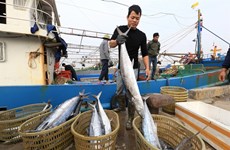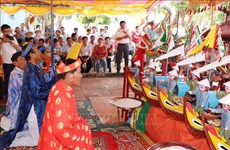Life sprouts from death
Late July's wind and sunshine bathed the forests of cacia and cajeput
trees in Dong Son commune while the green boundaries formed by locust
trees embraced the A So military airport, in A Luoi district, the
central province of Thua Thien-Hue.
Late July's wind and sunshine bathed the forests of cacia and cajeput
trees in Dong Son commune while the green boundaries formed by locust
trees embraced the A So military airport, in A Luoi district, the
central province of Thua Thien-Hue.
The beautiful images have made local people forget about the terrible warning of “no habitation, no cultivation, no husbandry and no fishing in Dong Son” once issued by the National Committee for Investigation of Consequences of Chemicals used during the war in Vietnam.
Dong Son commune, about 25km southwest of A Luoi's centre via the Ho Chi Minh Trail, was deemed the 'dead land' as it had been contaminated with Agent Orange (AO)/dioxin sprayed by the US in the 1961-1971 period.
In the decade, over 432,000 litres of herbicide, equivalent to 11kg of dioxin, were sprayed on the commune and A Luoi district all together.
The A So airport was once dubbed the “belly-button” of dioxin in Thua Thien-Hue.
During the war, the US used the airport to store herbicides and other types of chemicals, which resulted in the high level of dioxin in the soil, affecting both the ecological system and the human population in the area.
Today, A Luoi has 4,227 AO victims, of whom 61 are in Dong Son who live with cerebral palsy, neurological disease and paralysation.
According to A Viet Minh, Chairman of the Dong Son Communal People's Committee, people felt very worried about the risks caused by the deadly chemical as well as bombs and mines on the first days of settlement.
Nearly four decades after the national reunification, Dong Son is no longer a home of barbed wire, wasteland and bomb craters.
Based on initiatives raised by scientists, 30,000 locust trees have been planted, stretching nearly 3km to embrace the A So airport. The solution has helped reduce the harmful effects of dioxin and brought new vitality to the contaminated land while separating humans and animals from the dangerous area.
Dong Son has to date had 310 families with 1,360 people of Pako, Ta Oi, Ka Tu, H’re, Van Kieu and Kinh groups living harmoniously.
With 82 hectares of rice fields, the commune itself is self-supporting. Dong Son has also planted 500 hectares of commercial forests and taken the lead in A Luoi district in husbandry with about 310 cows, 145 buffalos and over 9,000 heads of poultry.
Apart from joining the national power grid, the locality has built schools and health clinics. By the end of 2011, with the support of the Vietnam-US Dialogue Group, a fresh water supply system was established, improving the lives of ethnic minorities.
They have also benefited from projects launched by the State and organisations both at home and abroad. They have been given technical and financial assistance in raising poultry and growing vegetables, rice and corn instead of long-term industrial trees that are low in productivity.
Recovering from a land filled with pains, Dong Son commune and A So airport are planned to shape part of a relic complex in A Luoi to commemorate the chemical war.
The 600 billion VND complex will encompass other devastated areas and a rehabilitation centre for AO victims.
Death has disappeared from Dong Son and local people’s suffering has been partially alleviated.
Despite this bright panorama, Chairman Minh said that Dong Son authorities and people will make greater efforts so the war and its consequences will no longer be the obsession in the future.-VNA
Previous: Detoxification – Hope for AO victims
AO victims refuse to surrender to fate
AO victims not alone in fight for justice
The beautiful images have made local people forget about the terrible warning of “no habitation, no cultivation, no husbandry and no fishing in Dong Son” once issued by the National Committee for Investigation of Consequences of Chemicals used during the war in Vietnam.
Dong Son commune, about 25km southwest of A Luoi's centre via the Ho Chi Minh Trail, was deemed the 'dead land' as it had been contaminated with Agent Orange (AO)/dioxin sprayed by the US in the 1961-1971 period.
In the decade, over 432,000 litres of herbicide, equivalent to 11kg of dioxin, were sprayed on the commune and A Luoi district all together.
The A So airport was once dubbed the “belly-button” of dioxin in Thua Thien-Hue.
During the war, the US used the airport to store herbicides and other types of chemicals, which resulted in the high level of dioxin in the soil, affecting both the ecological system and the human population in the area.
Today, A Luoi has 4,227 AO victims, of whom 61 are in Dong Son who live with cerebral palsy, neurological disease and paralysation.
According to A Viet Minh, Chairman of the Dong Son Communal People's Committee, people felt very worried about the risks caused by the deadly chemical as well as bombs and mines on the first days of settlement.
Nearly four decades after the national reunification, Dong Son is no longer a home of barbed wire, wasteland and bomb craters.
Based on initiatives raised by scientists, 30,000 locust trees have been planted, stretching nearly 3km to embrace the A So airport. The solution has helped reduce the harmful effects of dioxin and brought new vitality to the contaminated land while separating humans and animals from the dangerous area.
Dong Son has to date had 310 families with 1,360 people of Pako, Ta Oi, Ka Tu, H’re, Van Kieu and Kinh groups living harmoniously.
With 82 hectares of rice fields, the commune itself is self-supporting. Dong Son has also planted 500 hectares of commercial forests and taken the lead in A Luoi district in husbandry with about 310 cows, 145 buffalos and over 9,000 heads of poultry.
Apart from joining the national power grid, the locality has built schools and health clinics. By the end of 2011, with the support of the Vietnam-US Dialogue Group, a fresh water supply system was established, improving the lives of ethnic minorities.
They have also benefited from projects launched by the State and organisations both at home and abroad. They have been given technical and financial assistance in raising poultry and growing vegetables, rice and corn instead of long-term industrial trees that are low in productivity.
Recovering from a land filled with pains, Dong Son commune and A So airport are planned to shape part of a relic complex in A Luoi to commemorate the chemical war.
The 600 billion VND complex will encompass other devastated areas and a rehabilitation centre for AO victims.
Death has disappeared from Dong Son and local people’s suffering has been partially alleviated.
Despite this bright panorama, Chairman Minh said that Dong Son authorities and people will make greater efforts so the war and its consequences will no longer be the obsession in the future.-VNA
Previous: Detoxification – Hope for AO victims
AO victims refuse to surrender to fate
AO victims not alone in fight for justice













